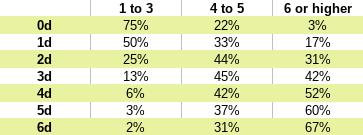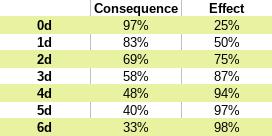The Forged in the Dark system from Blades in the Dark uses an action resolution system that is very similar to Apocalypse World but also slightly different. Just like in AW, all rolls are made with d6s and the possible outcomes are failure on a 1-3, partial success on 4/5, and full success on a 6. But instead of always rolling 2d6 and adding the appropriate attribute modifier to the result, FitD has you roll a number of d6s equal to the attribute rating and taking only the number from the highest dice as the result for the roll.
Usually I really don’t like dice pool mechanics (though I make an exception for Star Wars). I think my main objection is all the counting of dice, but in this system you don’t even have to do that. All you have to do is to look if you see any 6s, and if not if you see any 5s or 4s. There’s also a critical success if you have multiple sixes, but that still only requires you to tell the difference between “one six” and “multiple sixes”. This is stupidly simple. And still you get all the benefits from a dice pool system. Did any other games do this before? Did it take four decades of RPGs for someone to think of this?
The attribute rating a character can have for anything can range from 0 to 4 dice, but there are fairly simple ways to get another 2d on top of that. You could even get higher than that through situational modifiers, but here I’ve only taken it up to 6 dice. Starting characters probably have some points in about half of the 13 ratings, and it’s always up to the players which of their abilities they want to use. When you get attacked by enemies, nothing says that you have to cross swords with them to end the fight with a Skirmish roll. You can also end the fight by talking them down with a Skirmish roll, or make a daring escape with a Prowl or Finesse roll. It will lead to widely different results coming from a success or failure, but if you have the same ratings in the different abilities, the mechanics make no difference between them. And you can always chose to get a bonus die to any roll by adding to your character’s stress level. So if you don’t want to, you barely ever have to make a roll with less than 2 dice. Though if for some reason you want to make a roll with 0 dice, you roll 2 dice and take the lower number as your result.
Reading about the probabilities for 2d6 on Jeff’s Gameblog had me wondering how the actual odds are really looking for Forged in the Dark rolls, and I came up with this. (I don’t know how to easily calculate for two or more 6s for critical successes, but they are really just a slightly stronger versions of full successes on a single 6.)
 A result of 4 or 5 is a partial success, which means that you do the thing you wanted to do (an effect), but you also suffer a negative complication (a consequence). This can mean that you effectively get both a success and a failure at the same time, but the consequence can also simply be that you get a weaker version of what you intended to accomplish.
A result of 4 or 5 is a partial success, which means that you do the thing you wanted to do (an effect), but you also suffer a negative complication (a consequence). This can mean that you effectively get both a success and a failure at the same time, but the consequence can also simply be that you get a weaker version of what you intended to accomplish.
When rolling a single die, there is only a 50% chance of a full failure, which means a 50% that you get at least some success at what you tried to do. When you go to 2d, you’re already at 75% to get some kind of success. Above that, the probability that you just straight fail at your attempted action quickly becomes negligible. However, the chance to just get a full success with no negative consequences does not improve nearly as much.
 In this table, I added the chance for a partial success both to the odds for a failure and a full or critical success. This is the table that matters when you’re asking yourself “How much do I need to do what I want to do?” or “How much do I fear the possible consequences?” And I find the result very interesting. If you have invested some of your advancement points into an ability and take the stress penalties for an extra dice or two, the chances that your character succeeds at doing what you wanted to do are very high. But the odds that you will have to deal with a consequence starts at an extremely high level and always stays significant.
In this table, I added the chance for a partial success both to the odds for a failure and a full or critical success. This is the table that matters when you’re asking yourself “How much do I need to do what I want to do?” or “How much do I fear the possible consequences?” And I find the result very interesting. If you have invested some of your advancement points into an ability and take the stress penalties for an extra dice or two, the chances that your character succeeds at doing what you wanted to do are very high. But the odds that you will have to deal with a consequence starts at an extremely high level and always stays significant.
Overall, the odds for the possible results are hugely different between 0d and 6d, or even just between the more commonly encountered range of 1d to 5d. But regardless of what you roll, the partial success result in the middle means that you always have a good shot of getting what you want with your actions, but never rest assured that it will go smoothly. I think that’s actually brilliant for making a game always exciting.

Roll pool keep highest has been in use for at least 25 years.
Also, https://anydice.com/articles/blades-in-the-dark/
That’s a nice graph.